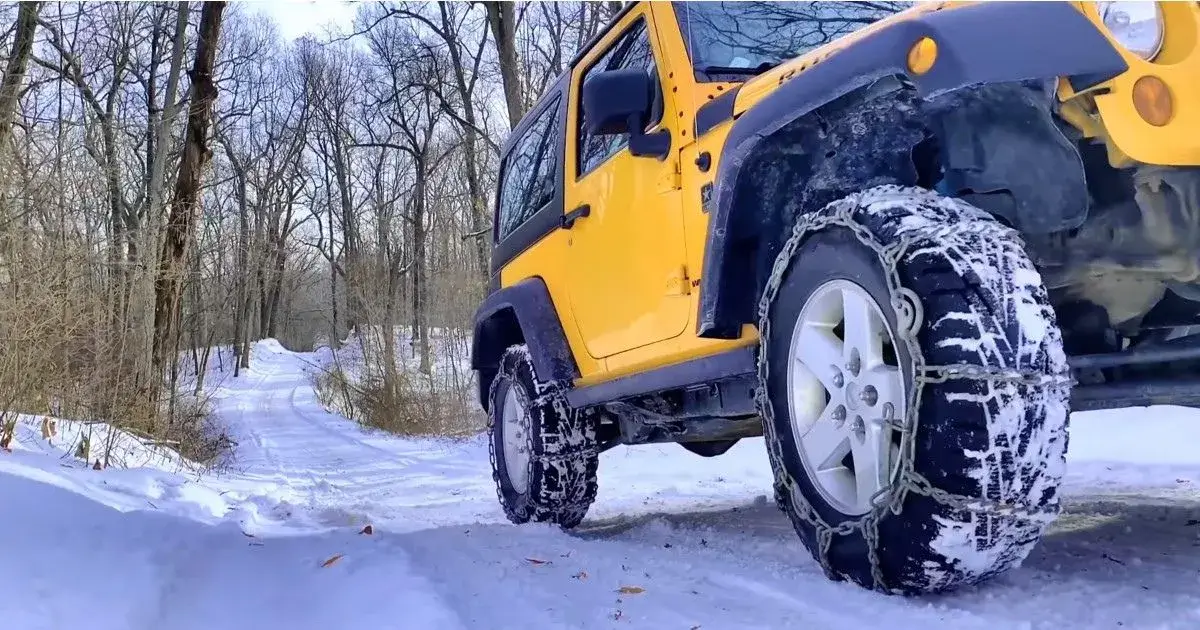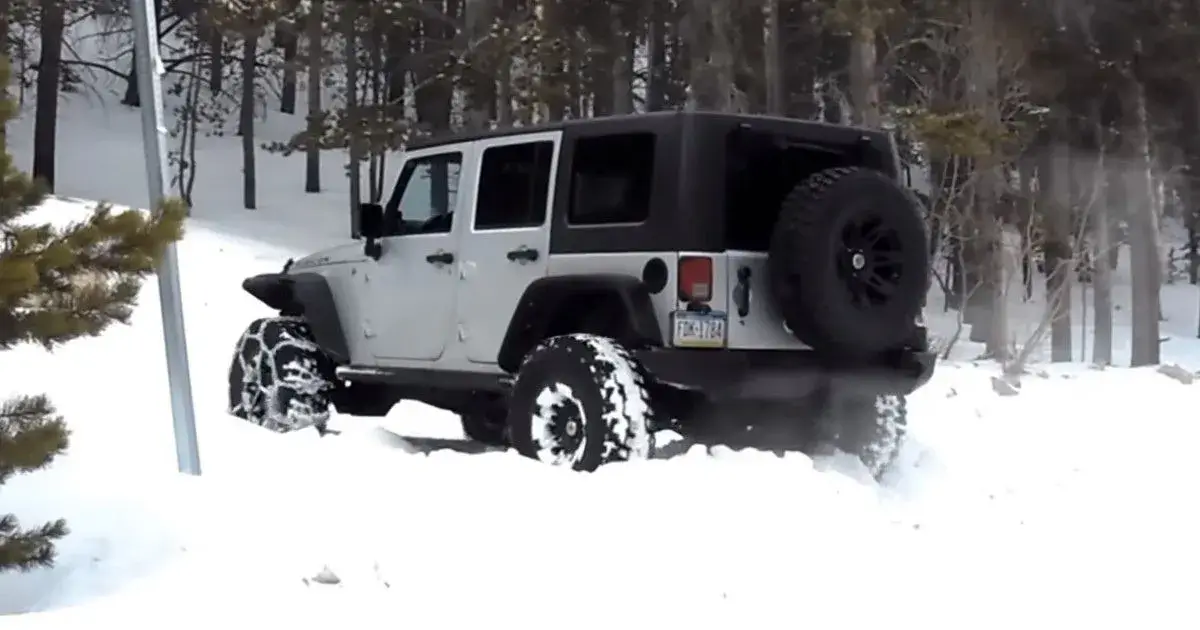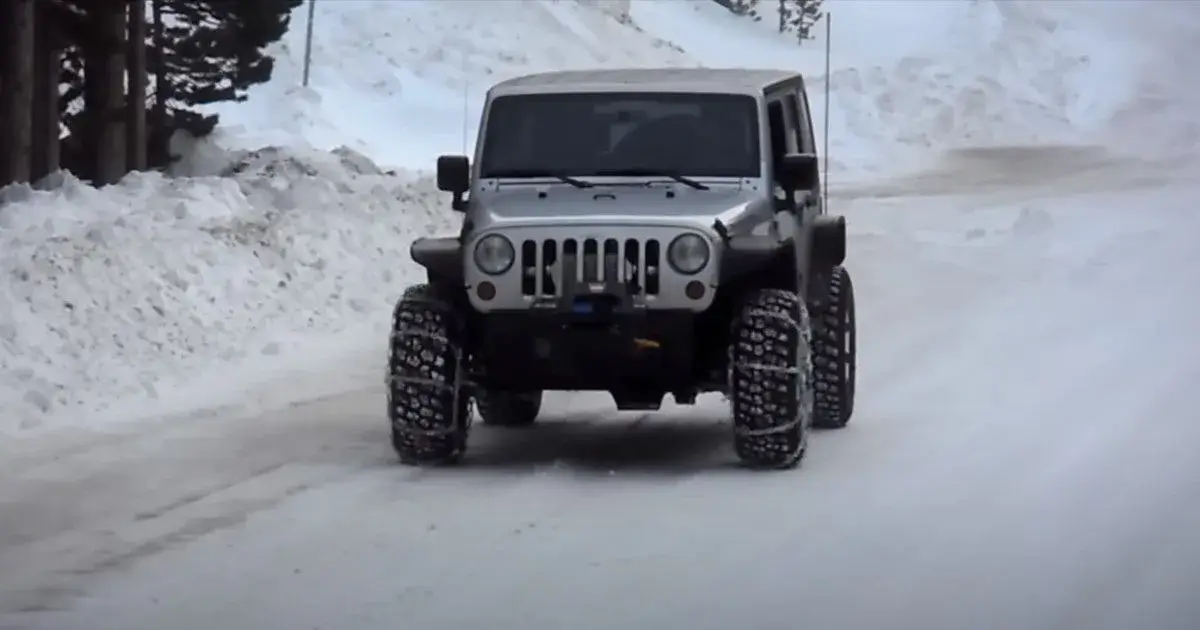Yes, Jeep Wranglers may need snow chains depending on the weather conditions and tire type.
Snow chains provide the necessary traction that your tires need to grip the snow and ice, making driving easier on snowy roads. However, it is important to note that not all Jeep Wrangler models and tires are created equal.
In this article, we will delve into the different factors that affect your decision, including the type of Jeep Wrangler you have, the type of tires you have, and the weather conditions in your area. We will also provide tips on using snow chains and where to buy them for your Jeep Wrangler.
So, if you’re planning a winter adventure with your Jeep Wrangler, keep reading to learn whether you need snow chains.

Understanding Snow Chains
Snow chains are devices that attach to a vehicle’s tires to provide additional traction on snowy or icy roads. They are made up of metal links or cables that wrap around the tire tread, helping it grip the road surface more effectively.
Different types of snow chains are available, including traditional ladder chains, cable chains, and diamond chains. Each type has advantages and disadvantages, and the best one for your vehicle depends on factors such as your driving conditions, tire size, and vehicle weight.
Snow chains can improve your vehicle’s handling and help you maintain control in slippery conditions, but they can also be difficult to install and remove. Additionally, they can cause damage to the road surface if not used properly, so it’s important to follow any guidelines or restrictions for their use in your area.
Jeep Wrangler Snow Chains
If you’re living in a snowy area or planning a winter road trip, you may wonder if you need to equip your Jeep with snow chains. After all, you want to ensure your safety and the safety of your passengers on snowy roads.
Snow chains are traction devices that help your vehicle control snowy and icy roads. But do Jeep Wranglers really need them? The answer is, it depends.
Jeep Wranglers are known for their off-road capabilities and can handle snow and ice pretty well. However, there are certain conditions where snow chains can be helpful, such as steep inclines or deep snow. It’s important to note that in some areas, using snow chains on certain roads may be a legal requirement, so it’s always a good idea to check your local regulations.
If you decide to use snow chains on your Jeep Wrangler, select the right type for your vehicle and follow the manufacturer’s instructions for installation. Improper installation or use can damage your tires or even cause an accident.
Snow Chains for Jeep Wrangler Unlimited
If you live in an area that gets a lot of snow, you know how important it is to have a good set of snow chains for your Jeep Wrangler Unlimited. Not only do they help you get around in the snow, but they also keep you safe.
Here are some things to consider when choosing the right snow chains for your Jeep Wrangler Unlimited.
The first thing to consider is the size of the chain. You want to ensure the chain is big enough to fit around your tires. If it’s too small, it won’t be able to provide the traction that you need.
The next thing to consider is the type of chain. There are two main types of chains – cable and link. Cable chains are easier to install but not as tough as link chains. Link chains are more difficult to install but much stronger and will last longer.
Once you’ve decided on the size and type of chain, you must decide how many you need. This will depend on the number of tires on your Jeep Wrangler Unlimited. If you have four tires, then you’ll need four chains. If you have six tires, then you’ll need six chains. And so on.
Considerations for Jeep Wrangler Owners
If you own a Jeep Wrangler and you’re wondering if you need snow chains, there are a few things you should consider. Jeeps are known for their off-road capabilities, but they can still struggle in snowy or icy conditions.
One thing to think about is the size of your tires. Jeeps often have larger tires than other vehicles, affecting how well they grip the road in snowy conditions. Additionally, the tread pattern on your tires can make a difference. If your tires have a more aggressive tread pattern, they might better handle snow and ice.
Another factor to consider is the weight of your Jeep. Heavier vehicles tend to have an easier time on snowy roads because they can push through the snow and get better traction. Jeeps are already pretty heavy, so this is definitely an advantage.
It’s also a good idea to check with Jeep or your tire manufacturer for any recommendations for using snow chains on your specific model. Some Jeeps might require chains, while others might not.
When to Use Snow Chains
Snow chains can be a great tool for driving in snowy or icy conditions, but they’re not always necessary. So when should you use them?
Snow chains can be a lifesaver if you live in an area with heavy snowfall or icy roads. They can give you more traction on the road, which can help you avoid accidents and maintain control of your vehicle.
It’s also a good idea to use snow chains if you plan on driving in areas where they’re required by law. Some states or regions have laws that require drivers to use chains on certain roads during winter months.
However, there are some situations where snow chains might not be necessary. For example, if you live in an area with mild winters and don’t encounter much snow or ice, you might not need them. Additionally, if you have a vehicle with all-wheel drive or 4-wheel drive, you might not need snow chains as those vehicles tend to have better traction in snowy conditions.

How to Put Chains on a Jeep Wrangler
If you live in an area with snow and ice, you know how important it is to have chains on your Jeep Wrangler. Not only do they help you get better traction, but they also keep you from sliding all over the place. Here’s a step-by-step guide on how to put chains on your Jeep Wrangler:
Choose the right type of snow chains
Select snow chains compatible with the size and type of tires on your Jeep Wrangler. There are two main types of snow chains: ladder-style and diamond-pattern. Ladder-style chains are easier to install, while diamond-pattern chains offer better traction on ice.
Prepare your Jeep
Before installing snow chains, ensure your Jeep is parked on a level surface and the emergency brake is engaged. Also, clear any snow or ice buildup from your tires.
Install the chains on the rear tires first
Start by attaching the chains to the top of the tire, then work around the tire, ensuring the chain is snug and centered. Follow the manufacturer’s instructions carefully, as the installation process may vary depending on the type of chains you have.
Move to the front tires
Once the rear tires are done, move on to the front tires and repeat the same process. Remember to keep the chains centered and snug, and ensure they don’t touch any brake lines or suspension components.
Adjust the tension
After installing the chains on all four tires, move your Jeep forward a few feet, then stop and check the tension. Depending on the fit, you may need to adjust the chains to make them tighter or looser.
Test drive
Once the chains are properly installed and tensioned, take your Jeep for a test drive on a quiet road to ensure they work correctly. Be sure to drive slowly and cautiously, as snow chains can affect handling and braking.
Remember, snow chains on your Jeep Wrangler can help improve traction and control on snowy or icy roads, but they’re not a substitute for safe driving practices. Always adjust your speed and driving habits to suit the conditions, and stay safe out there!
Tips for safe and effective use of snow chains
Snow chains can be a great tool for improving traction on snowy and icy roads, but using them safely and effectively is important. Here are some tips to keep in mind:
Practice before you hit the road
Installing snow chains can take some practice, so trying it out in your driveway or a parking lot before you need them on the road is good. This will help you get familiar with the process and ensure you’re doing it correctly.
Only use chains when necessary
While snow chains can be helpful in certain conditions, they’re not always needed. Only use them when the roads are covered in snow or ice and your Jeep has trouble maintaining traction.
Don’t exceed the recommended speed
Snow chains can affect handling and braking, so driving slowly and carefully is important. Most manufacturers recommend a maximum speed of 30-35 mph when using snow chains.
Avoid sharp turns
Snow chains can cause your Jeep to handle differently than usual, so avoiding sharp turns or sudden manoeuvres is best. Instead, plan and give yourself plenty of time to slow down and make gradual turns.
Check the tension frequently
Snow chains can loosen over time, so checking the tension frequently and adjusting as needed is important. If the chains are too loose, they won’t provide enough traction. If they’re too tight, they can damage your tires or suspension.
Remove the chains when you don’t need them
Once you’re back on dry pavement, remove the snow chains as soon as possible. Driving with chains on dry roads can damage your tires and reduce fuel efficiency.

Best Snow Chains for Jeep Wrangler
If you live in an area where it snows frequently, you know how important it is to have a good set of snow chains for your Jeep Wrangler. But with so many different types and brands of snow chains on the market, it can be difficult to know which ones are the best for your vehicle.
Here at 4 Wheel Parts, we’ve compiled a list of the best snow chains for Jeep Wranglers, based on customer reviews and our testing.
First up on our list is the Security Chain Company Super Z6 Cable Tire Chain. This chain is designed specifically for SUVs and light trucks, and it’s made from hardened steel for maximum strength and durability. The Super Z6 also has a patented cam-action tightening system, making installation quick and easy.
If you’re looking for an affordable option that doesn’t sacrifice quality, look at the Titan Chain All-Terrain Snow Tire Chains. These chains are made from manganese alloy steel for long-lasting performance, and they’re designed to fit most SUVs, light trucks, and crossovers.
The Titan Chains also come with a convenient carrying case, so you can store them in your Jeep when they’re not in use.
Finally, we have the Konig XG12 Pro Snow Chain. This chain is specifically designed for high-performance vehicles like the Jeep Wrangler, and it features reinforced links and studded pins for added traction on icy roads. The XG12 Pro is also one of the easiest snow chains to install thanks to its ratchet-style tensioning system.
Practice installing them before using them in an emergency, no matter which type of snow chain you choose. Always check your local laws before using tire chains – some states restrict when they can be used (typically during winter weather advisories).
FAQs
Are Jeep Wranglers Safe in Snow?
A Jeep Wrangler is a great option if you’re looking for a vehicle that can handle snow. The Wrangler’s four-wheel drive and high ground clearance enable it to tackle deep snow and icy conditions.
Plus, the Jeep’s tough build means it can withstand the rigors of off-roading, should you decide to take your adventure off the beaten path.
Do You Need Chains If You Have a Jeep?
No, you don’t need chains if you have a Jeep. However, if you live in an area with frequent snowstorms, keeping chains in your Jeep in case you get stranded in the snow is a good idea.
Can a Jeep Wrangler Get Stuck in Snow?
A Jeep Wrangler is a great off-road vehicle that can handle most terrain and weather conditions. However, like all vehicles, it has its limits and can get stuck in the snow if you’re not careful. Here are some tips to avoid getting your Jeep stuck in the snow:
Avoid driving in deep snow: If you must drive through deep snow, take it slow and prepare for the worst. Try to find a path that has been driven on already, so you don’t have to plow through fresh powder.
Use tire chains or studded tires: This will give you better traction and help prevent your wheels from spinning uselessly.
Know your vehicle’s limitations: Every Jeep is different, so make sure you know how yours will react in different situations before heading out into the wild. Test it out in a safe area first if possible.
How Do You Drive a Jeep Wrangler in Snow?
If you’re lucky enough to own a Jeep Wrangler, then you know that this vehicle is built for off-roading. But what happens when the off-road terrain is covered in snow? Do you have to park your Jeep until the snow melts?
Not at all! You can still enjoy driving your Jeep Wrangler in the snow, but there are a few things you need to keep in mind.
First, it’s important to equip your Jeep with the right tires. All-terrain, mud, and snow tires will give you the best traction on slippery surfaces.
Second, ensure you have plenty of clearance between the bottom of your Jeep and the ground. This will help prevent getting stuck in deep snow drifts.
Finally, take it slow and easy when driving on snowy roads. Sudden stops or sharp turns could cause you to lose control of your Jeep. By following these tips, you can continue to enjoy driving your Jeep Wrangler all year round – even when the roads are covered in snow!
Jeep Rubicon with tire chains vs steep snow covered hill
Wrapping Up
In conclusion, whether you need snow chains for your Jeep Wrangler depends on your driving conditions. If you live in an area with heavy snow and ice or plan to take your Jeep off-road in the winter, snow chains can improve traction and control.
When using snow chains, it’s important to choose the right type for your Jeep’s tires and to install them correctly and securely. Remember to drive slowly and carefully and to adjust your driving habits to suit the conditions.
Finally, if you decide to use snow chains on your Jeep, practice installing and removing them before you need them on the road. With a little preparation and some common sense, you can stay safe and in control on even the snowiest of roads.

